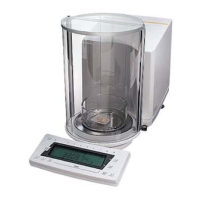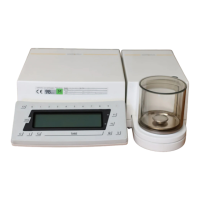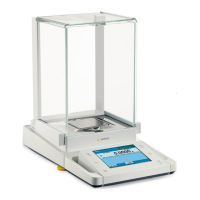Changing the Density of a Sample
Enter the density of a sample using the numeric keys and then confirm this value
by pressing the F key identified by “STO.” Afterwards, the density that you
entered will be shown in the application display. This density is used to calculate
the absolute mass of the sample on the balance.
The density must be entered in grams per cubic centimeter (g/cm
3
). A density
may not be greater than 22.5 g/cm
3
or less than 0.1 g/cm
3
. The density that you
enter will be stored in the non-volatile memory.
Recalling a Stored Density
You can recall the density that you last used by pressing the F key identified
in the display by “STO.”
Press the w key at any time to toggle between weight and mass.
Air Buoyancy Correction after an Air Density Determination
A special function makes it possible to determine and store the air density (for more
information see p.3–9). The density can be between 1.0 kg/m
3
and 1.4 kg/m
3
.
If the air density determined deviates from the standard value of 1.2 kg/m
3
,
the F key normally identified by STO is shown as STO
●
.
Use in Combination with Other Programs
The air buoyancy correction program can be used in combination with
other application programs. This means you will have all functions of the
combined program available in addition.
Program Code
Over/under checkweighing (net weight) 2 2 3
Over/under checkweighing (difference in weight) 2 2 4
3–7

